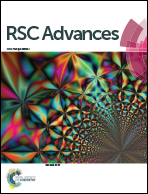Theoretical study on the electronic structure and second-order nonlinear optical properties of benzannulated or selenophene-annulated expanded helicenes†
Abstract
Currently, discovering new materials with superior second-order nonlinear optical (NLO) performance has become a very hot research topic in the fields of chemistry and materials science. Now, density functional theory (DFT) has become a powerful tool to predict the performance of novel materials. In this paper, based on benzannulated and selenophene-annulated expanded helicenes, twenty-six helicenes are designed by introduction donor/acceptor moieties and their combinations at different substituent positions. The geometrical/electronic structures, electronic transition, and second-order NLO properties of these helicenes are full investigated by DFT/TDDFT theory. The investigations show that these helicenes have large first hyperpolarizability values (βHRS). For instance, the βHRS value (29.95 × 10−30 esu) of helicene H24 is about 7 times larger than that of the highly π-delocalized phenyliminomethyl ferrocene complex. In addition, the introduction of acceptor NO2 unit at R7 and R8 positions for helicenes H1 and H15 can obtain the largest βHRS value, which is attributed to the enhancement of electron acceptor ability. In view of large NLO response and intrinsic asymmetric structures, the studied helicenes have the possibility to be excellent second-order NLO materials.



 Please wait while we load your content...
Please wait while we load your content...